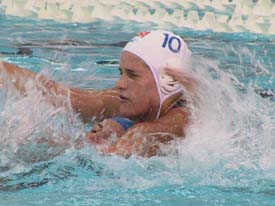When athletes of any caliber come to physical therapy appointments, they often struggle with emotional hurdles as big as their physical challenges. Working with an expert who understands their struggles can make it easier to cope, especially when that expert is a former Olympian.
Robin Beauregard, a physical therapist at CHOC and two-time Olympic medalist in women’s water polo, understands the physical challenges that can sometimes stand in the way of achieving athletic goals.

“Having a career in athletics helps me establish a rapport with my patients, particularly my history with sustaining and overcoming injuries,” she says. “Sincere empathy creates a stronger bond than sympathy.”
Shortly before the team was named for the Sydney Olympics in 2000, the first time women’s water polo was to be recognized as an Olympic sport, Beauregard dislocated her knee and didn’t know if a recovery was possible. Distraught but determined, she committed fully to her physical therapy plan, as well as a rigorous conditioning program, and made the team. They’d win a silver medal that year, and a bronze four years later. She was later inducted into the USA Water Polo Hall of Fame.
Beauregard’s experience with physical therapy in the midst of her Olympic career ultimately played a big role in her professional career.
“I was not the perfect patient, but it prepared me for being a physical therapist because it gave me an idea of asking only what is reasonable of my teen and young adult patients,” she says. “I really do understand their worry of not being able to get back to the top level in their sport, but also weighing the risks of not wanting to cause further or permanent injury.”
Growing up in Southern California, Beauregard loved to be outdoors and was always active. Having an older brother who was also athletic made her competitive, too. She started swimming competitively for a local club team on her fourth birthday simply because her brother swam, and she wanted to be as a good as he was. Water polo came into play just four years later, and by age 8 she joined a competitive club team.
But when she got to high school, there was no girls’ varsity team. Instead of giving up on her passion, she simply joined the boys’ team instead. Playing with the boys didn’t faze her, or them, since they’d been competing together for almost a decade by that point. When opponents made comments about playing with a girl, she channeled it into her game and used it as fuel to play even harder.
After high school, she attended UCLA to play water polo, and originally planned on becoming an orthopedic surgeon. She later changed her path to physical therapy, which would ultimately give her a different kind of interaction with patients and athletes.




